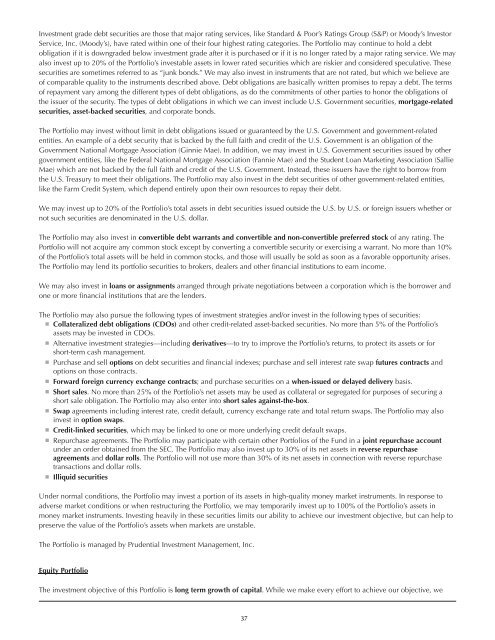The Prudential Series Fund
The Prudential Series Fund
The Prudential Series Fund
You also want an ePaper? Increase the reach of your titles
YUMPU automatically turns print PDFs into web optimized ePapers that Google loves.
Investment grade debt securities are those that major rating services, like Standard & Poor’s Ratings Group (S&P) or Moody’s Investor<br />
Service, Inc. (Moody’s), have rated within one of their four highest rating categories. <strong>The</strong> Portfolio may continue to hold a debt<br />
obligation if it is downgraded below investment grade after it is purchased or if it is no longer rated by a major rating service. We may<br />
also invest up to 20% of the Portfolio’s investable assets in lower rated securities which are riskier and considered speculative. <strong>The</strong>se<br />
securities are sometimes referred to as “junk bonds.” We may also invest in instruments that are not rated, but which we believe are<br />
of comparable quality to the instruments described above. Debt obligations are basically written promises to repay a debt. <strong>The</strong> terms<br />
of repayment vary among the different types of debt obligations, as do the commitments of other parties to honor the obligations of<br />
the issuer of the security. <strong>The</strong> types of debt obligations in which we can invest include U.S. Government securities, mortgage-related<br />
securities, asset-backed securities, and corporate bonds.<br />
<strong>The</strong> Portfolio may invest without limit in debt obligations issued or guaranteed by the U.S. Government and government-related<br />
entities. An example of a debt security that is backed by the full faith and credit of the U.S. Government is an obligation of the<br />
Government National Mortgage Association (Ginnie Mae). In addition, we may invest in U.S. Government securities issued by other<br />
government entities, like the Federal National Mortgage Association (Fannie Mae) and the Student Loan Marketing Association (Sallie<br />
Mae) which are not backed by the full faith and credit of the U.S. Government. Instead, these issuers have the right to borrow from<br />
the U.S. Treasury to meet their obligations. <strong>The</strong> Portfolio may also invest in the debt securities of other government-related entities,<br />
like the Farm Credit System, which depend entirely upon their own resources to repay their debt.<br />
We may invest up to 20% of the Portfolio’s total assets in debt securities issued outside the U.S. by U.S. or foreign issuers whether or<br />
not such securities are denominated in the U.S. dollar.<br />
<strong>The</strong> Portfolio may also invest in convertible debt warrants and convertible and non-convertible preferred stock of any rating. <strong>The</strong><br />
Portfolio will not acquire any common stock except by converting a convertible security or exercising a warrant. No more than 10%<br />
of the Portfolio’s total assets will be held in common stocks, and those will usually be sold as soon as a favorable opportunity arises.<br />
<strong>The</strong> Portfolio may lend its portfolio securities to brokers, dealers and other financial institutions to earn income.<br />
We may also invest in loans or assignments arranged through private negotiations between a corporation which is the borrower and<br />
one or more financial institutions that are the lenders.<br />
<strong>The</strong> Portfolio may also pursue the following types of investment strategies and/or invest in the following types of securities:<br />
■ Collateralized debt obligations (CDOs) and other credit-related asset-backed securities. No more than 5% of the Portfolio’s<br />
assets may be invested in CDOs.<br />
■ Alternative investment strategies—including derivatives—to try to improve the Portfolio’s returns, to protect its assets or for<br />
short-term cash management.<br />
■ Purchase and sell options on debt securities and financial indexes; purchase and sell interest rate swap futures contracts and<br />
options on those contracts.<br />
■ Forward foreign currency exchange contracts; and purchase securities on a when-issued or delayed delivery basis.<br />
■ Short sales. No more than 25% of the Portfolio’s net assets may be used as collateral or segregated for purposes of securing a<br />
short sale obligation. <strong>The</strong> Portfolio may also enter into short sales against-the-box.<br />
■ Swap agreements including interest rate, credit default, currency exchange rate and total return swaps. <strong>The</strong> Portfolio may also<br />
invest in option swaps.<br />
■ Credit-linked securities, which may be linked to one or more underlying credit default swaps.<br />
■ Repurchase agreements. <strong>The</strong> Portfolio may participate with certain other Portfolios of the <strong>Fund</strong> in a joint repurchase account<br />
under an order obtained from the SEC. <strong>The</strong> Portfolio may also invest up to 30% of its net assets in reverse repurchase<br />
agreements and dollar rolls. <strong>The</strong> Portfolio will not use more than 30% of its net assets in connection with reverse repurchase<br />
transactions and dollar rolls.<br />
■ Illiquid securities<br />
Under normal conditions, the Portfolio may invest a portion of its assets in high-quality money market instruments. In response to<br />
adverse market conditions or when restructuring the Portfolio, we may temporarily invest up to 100% of the Portfolio’s assets in<br />
money market instruments. Investing heavily in these securities limits our ability to achieve our investment objective, but can help to<br />
preserve the value of the Portfolio’s assets when markets are unstable.<br />
<strong>The</strong> Portfolio is managed by <strong>Prudential</strong> Investment Management, Inc.<br />
Equity Portfolio<br />
<strong>The</strong> investment objective of this Portfolio is long term growth of capital. While we make every effort to achieve our objective, we<br />
37
















